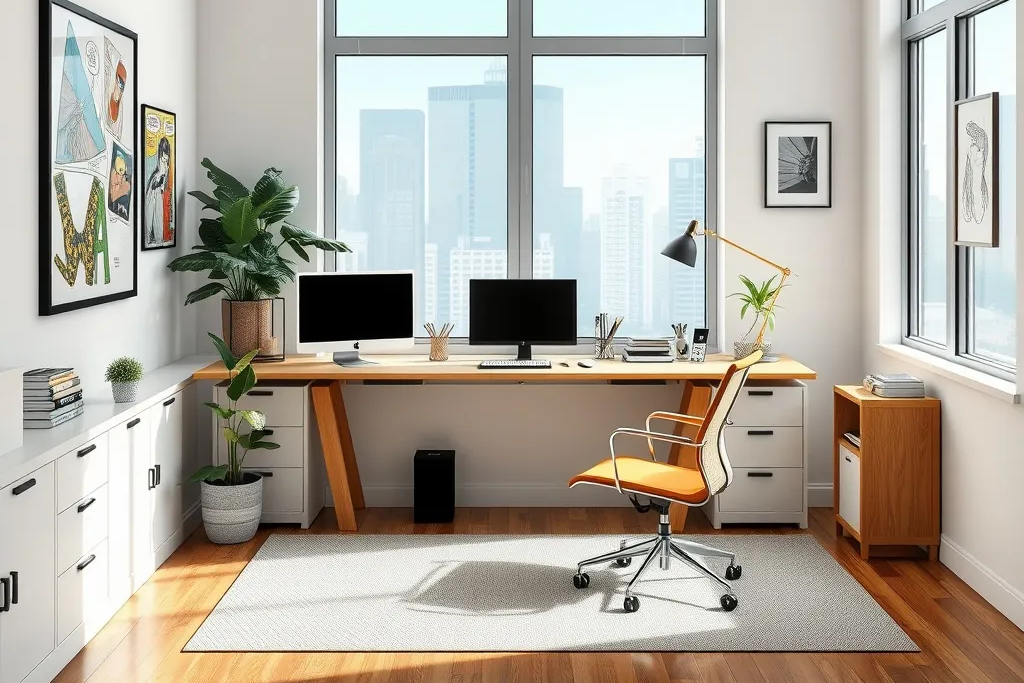After fifteen years transitioning between corporate cubicles, makeshift dining table setups, and finally designing a dedicated home workspace, it’s clear that a home office is far more than just furniture and equipment—it’s an ecosystem that either nurtures or hinders your best work. When the pandemic forced many architecture firms to go remote in 2020, hastily assembled corner desks in guest bedrooms quickly revealed their inadequacies. Three years, countless adjustments, and one major renovation later, here are the distilled lessons on what truly makes a difference between an office that depletes you and one that helps you thrive.
Finding Your Space: Location Matters More Than You Think
The conventional wisdom says to find the quietest, most isolated spot in your home. After trying four different locations, it’s not quite that simple.
A corner of the bedroom proved disastrous. The psychological blurring between work and rest created a situation where neither work nor sleep happened properly. Using a rarely-used dining room seemed practical until every family meal meant clearing away work materials, interrupting ongoing projects.
The breakthrough came with the realization that needs vary throughout the day. Some work requires deep concentration and isolation, while other tasks benefit from ambient activity and natural interruptions. An unconventional but transformative solution emerged: creating a primary workspace in a renovated attic, with a secondary “satellite” desk in the periphery of the living area for specific tasks that benefit from being in the household flow.
Consider your own work patterns before deciding on location. Do you thrive with occasional ambient noise, or does every distraction derail your focus? Do you need frequent access to materials in other parts of the house? Would a view of nature reset your thinking during mental blocks? Your answers should guide your choice more than conventional advice.
For those in smaller spaces without multiple options, even the orientation of your desk can make a tremendous difference. In studio apartment days, simply shifting a desk to face the wall instead of the television can change productivity immeasurably.
The Foundation: Desk & Chair As Your Primary Tools
Desks: Finding Your Perfect Work Surface
After experimenting with multiple desks over the years, it’s clear this choice is surprisingly personal and dependent on your specific work style.
A custom-built desk with a Baltic birch plywood top mounted on adjustable standing legs came after years of experimentation. The revelation wasn’t in finding the “best” desk, but in understanding that different types of work require different configurations.
For computer workers, depth matters more than width. A desk that’s 30 inches deep rather than the standard 24 creates space for monitor placement that doesn’t strain the neck. If you work with physical materials—drafting, crafting, or spreading out documents—width becomes more critical.
For those considering standing desks, the mechanism matters tremendously. A crank-operated Ikea model might go unused after the novelty wears off because changing positions requires too much effort. Models with preset heights get used in standing mode daily because the transition takes seconds.
Some truthful observations on popular options:
- Fully Jarvis Standing Desk: After two years of daily use, it’s extremely stable even at full height. The motor is whisper-quiet, and the bamboo top weathers coffee spills and heavy use beautifully. The cable management tray is worth the extra cost.
- Branch Standing Desk: These are found in many offices. Slightly less stable than the Jarvis at full height, but the control panel is more intuitive, and the built-in cable management is superior.
- IKEA Bekant: Functional but noticeably wobblier than premium options, and the height adjustment buttons require continuous pressing rather than presets.
- Vintage Hardwood Desks: Nothing matches their character and craftsmanship, but be realistic about their ergonomics. A beautiful 1940s teacher’s desk might look stunning but cause back pain without modifications like a pull-out keyboard tray.
For those on tight budgets, table tops from IKEA paired with separately purchased adjustable legs can create a custom solution for less than $200. This approach for a writing desk in the living area can hold up remarkably well even after years of use.
Chairs: The Most Personal Choice
Many people would advise their younger selves to spend less on their first “real” desk and more on their chair. After developing persistent lower back pain from a cheap office chair, investing in a refurbished Herman Miller Aeron can bring almost immediate relief.
The chair revelation comes when realizing that different body types require fundamentally different chairs. Someone shorter might find a beloved Aeron uncomfortable but love a Steelcase Gesture. Chair preferences are shockingly personal.
Some honest observations from experience:
- Herman Miller Aeron: The mesh design eliminates the sweaty-back syndrome experienced with leather chairs. The PostureFit SL support can transform lower back comfort, but people under 5’5″ often find it uncomfortable regardless of size.
- Steelcase Gesture: Perhaps less immediate comfort than the Aeron, but often provides better long-term comfort during 8+ hour workdays. The armrests with their exceptional adjustability make this superior for those who switch between typing, mousing, and tablet use.
- Herman Miller Embody: Worth mentioning for its almost cult-like following among developers. The “pixelated support” isn’t marketing hype—it genuinely distributes pressure differently. However, it’s polarizing; people either love it immediately or find it bizarre.
- Humanscale Freedom: The headrest version provides excellent upper back support, but the seat depth isn’t adjustable enough for taller frames.
- Gaming Chairs: After testing various models, many find they prioritize looks over true ergonomics. The racing-style bolsters force a fixed position rather than supporting natural movement.
For those unable to invest in premium chairs, adding a quality lumbar support pillow (like the Purple Back Cushion) and a proper footrest can transform a mediocre chair into something workable. Still, if you work from home regularly, the chair should be your splurge item—your back in ten years will thank you.
Technology: Beyond the Basics
Monitors & Display Setup
After cycling through various configurations, a 27-inch 4K primary monitor on an adjustable arm, paired with a 24-inch vertical secondary monitor for reference materials and communication apps, can prove ideal for many workflows.
Some insights from experience:
- Monitor arms provide more flexibility than fixed stands and reclaim valuable desk space. An Ergotron LX can hold up for years of daily adjustments.
- For creative work, color accuracy matters more than resolution. A Dell UltraSharp’s 99% sRGB coverage can prove more valuable than a 5K display with poorer color representation.
- For text-heavy work, pixel density dramatically reduces eye strain. Moving from 1080p to 4K on the same size screen can eliminate end-of-day headaches.
- If desk space is limited, ultrawide monitors can be a productivity boon. A 34-inch curved ultrawide might transform workflows for design applications.
For those using laptops as their primary computers, consider the ergonomic nightmare of hunching over a laptop screen. A laptop stand that brings the screen to eye level, paired with an external keyboard and mouse, can prevent neck and shoulder issues that develop from poor positioning.
The Connectivity Foundation
The least glamorous but possibly most important element of a functional home office is robust connectivity. Several changes can transform your work experience:
- Hardwired connections whenever possible: Running an ethernet cable to your office can eliminate video call freezes. For situations where cables aren’t practical, a mesh Wi-Fi system (like Eero Pro) maintains consistent speeds throughout challenging home layouts.
- Dedicated circuits: Experiencing flickering lights during heavy computer use might signal electrical issues. Adding a dedicated circuit can eliminate mysterious computer crashes and provide peace of mind for expensive equipment.
- Thoughtful cable management: Beyond aesthetics, proper cable organization prevents the frustration of hunting for the right cable and the eventual damage from tangled wires. An under-desk cable tray with attached power strip means never having to crawl under the desk to plug something in.
- UPS (Uninterruptible Power Supply): After losing hours of work to a brief power outage, a CyberPower UPS gives roughly 20 minutes to save work and shut down properly during power failures.
Peripherals That Matter
After trying countless keyboards, mice, and accessories, peripheral preferences prove deeply personal. However, certain investments consistently improve the work experience:
- Mechanical Keyboards: The tactile feedback from a Keychron K2 can reduce typing fatigue during long writing sessions. The audible click response is satisfying but problematic during calls, making Brown switches that provide tactile feedback without the distinctive click a good alternative.
- Vertical Mouse: Switching to a Logitech MX Vertical can eliminate wrist pain many come to consider normal. The adjustment period of about two weeks is absolutely worth it.
- Document Scanner: A Fujitsu ScanSnap transforms paperwork processes. Piles of papers become searchable PDFs, reclaiming both physical space and mental bandwidth.
- Webcam & Microphone: Video call quality affects how colleagues perceive your professionalism. Upgrading from built-in options to a Logitech C920 camera and a Blue Yeti microphone often results in fewer interruptions during team calls and more consideration given to your input.
Creating Atmosphere: The Overlooked Elements
After the functional elements are in place, the atmosphere of your office significantly impacts your psychological state while working. Some elements that make a measurable difference:
Lighting Layers
Nothing improves an office environment more dramatically than proper lighting. A three-layer approach works best:
- Ambient lighting that brightens the entire room (ceiling-mounted fixtures that can adjust color temperature throughout the day)
- Task lighting focused on the work surface (an adjustable desk lamp)
- Accent lighting that reduces eye strain from contrast (a small LED strip behind the monitor and targeted lighting on shelves to reduce the contrast between bright screens and surroundings)
The ability to adjust color temperature can transform the work experience. Cooler, brighter light helps focus during analytical tasks, while warmer tones support creative work and reduce eye strain in the evening.
Acoustics
Hard surfaces can create subtle but fatiguing sound reflections. Adding strategic soft elements transforms both the sound and feel of the space:
- A wool rug under the desk chair improves acoustics while defining the space visually
- Acoustic panels disguised as artwork on opposite walls reduce echo significantly
- A small bookcase filled with books creates an irregular surface that diffuses sound
For those in noisy environments, active solutions make a tremendous difference. Quality noise-canceling headphones can transform the ability to focus in less-than-ideal acoustic environments, from coffee shops to temporary office setups.
Biophilia: The Living Element
Research on plants in workspaces indicates they do more than look nice—they can improve air quality, boost mood, and enhance creativity. Some resilient options include:
- ZZ Plants: Thrive despite erratic watering and north-facing windows
- Snake Plants: Survive weeks of neglect during travel and seem to prefer being forgotten
- Pothos: Grow enthusiastically even in dim corners
For those without natural light, high-quality artificial plant options have improved dramatically in recent years. Even skeptics might be surprised by how realistic modern faux plants can appear.
Personalization
The final element that transforms a functional office into a space that supports your best work is thoughtful personalization. This goes beyond decorative objects to include elements that actually support your cognitive and emotional needs.
Functional Art
Instead of generic office decorations, surrounding yourself with images related to your work and interests improves both mood and creativity:
- Framed maps of cities you’ve worked in, which might spark solutions when stuck on similar problems
- Small sculptures that demonstrate interesting principles related to your field
- Historic photographs that remind you of foundational principles when modern trends lead you astray
Deliberate Inspiration
A small, rotating gallery space—simply a floating shelf with a small easel—where you place images, quotes, or objects related to current projects can be transformative. This “inspiration station” changes weekly and keeps visual inspiration fresh without creating clutter.
State-Shifting Elements
Different work requires different cognitive states. Creating small “stations” helps transition between:
- Deep analytical work (noise-canceling headphones, specific lighting preset)
- Creative ideation (standing desk position, whiteboard access)
- Communication mode (webcam-ready position, different chair height)
The physical act of changing these elements signals a mental shift that helps transition between different types of work more effectively.
Real-World Workspaces: Beyond the Idealized Instagram Office
Instagram and design magazines showcase stunning offices that often prioritize aesthetics over function. Here are insights from remarkable yet realistic workspaces:
The Writer’s Functional Focus
A bestselling novelist maintains a spartan office that challenges conventional wisdom about creative spaces. Her desk faces a blank wall—deliberately removing visual distractions—and her chair is a basic task chair from IKEA. The magic comes from her sound design: customized ambient noise played through high-quality speakers that changes based on what type of scene she’s writing. For intense dialog, she uses cafe sounds; for action sequences, subtle film scores; for emotional scenes, specific playlists that evoke the mood she’s creating.
The Entrepreneur’s Command Center
A successful entrepreneur created what he calls a “command center” designed for rapid context switching. Three defined areas occupy the same room:
- A standing desk with dual monitors for intensive analytical work
- A comfortable armchair with good lighting and a laptop stand for reading and reviewing
- A small round table for video calls and conversations
The genius is in the transitions—he physically moves between these stations when changing tasks, creating a bodily ritual that helps his brain context-switch more effectively.
The Hybrid Worker’s Adaptable Setup
A hybrid worker who’s home three days a week created a fascinating convertible setup. Her home office doubles as a guest room, but instead of the typical Murphy bed, she designed a wall-mounted desk that folds up to reveal a neatly made bed behind it. Pull-out nightstands and sconces mounted at perfect heights for both work and reading in bed make the space fully functional in both configurations.
Evolving Your Space: The Ongoing Experiment
Perhaps the most important lesson is that a home office is never truly “finished.” As your work evolves, your space should adapt alongside it. Scheduling a quarterly “office review” helps assess what’s working and what needs adjustment.
Questions to ask during these reviews:
- What tasks am I avoiding, and could my environment be contributing to that resistance?
- Where do I lose time during transitions between different types of work?
- What physical discomfort have I been ignoring or accommodating?
- Which elements of my space bring me joy or energy when I use them?
- What technology is creating friction in my workflow?
These regular check-ins prevent the accumulation of small inconveniences that can gradually erode productivity and well-being.
The Personal Journey
Creating your ideal workspace is ultimately a deeply personal journey of discovery. While ergonomic principles and design guidelines provide important foundations, your perfect office will reflect your unique work patterns, sensory preferences, and professional needs.
The most effective home office isn’t necessarily the most beautiful or expensive—it’s the one that becomes almost invisible during work because it supports you so seamlessly. When you finish a day in your workspace feeling accomplished rather than depleted, you’ll know you’re on the right track.
After many years of refinement, a home office continues to evolve with your work. Each change teaches something valuable about your own needs and workflow. Approach your space with the same spirit of experimentation and self-discovery. Your ideal office isn’t waiting in a catalog or Instagram feed—it’s waiting to be created through your own process of thoughtful iteration.




